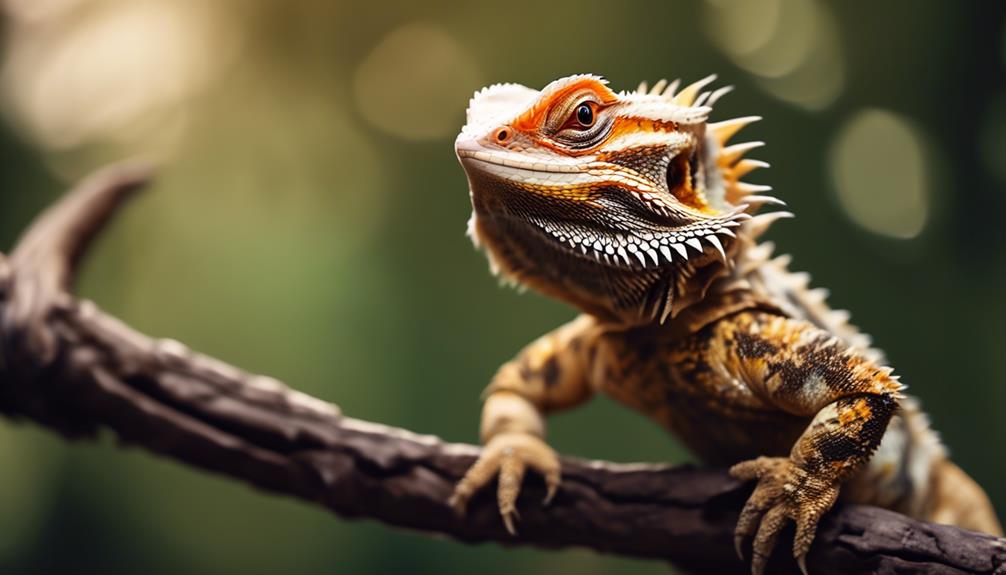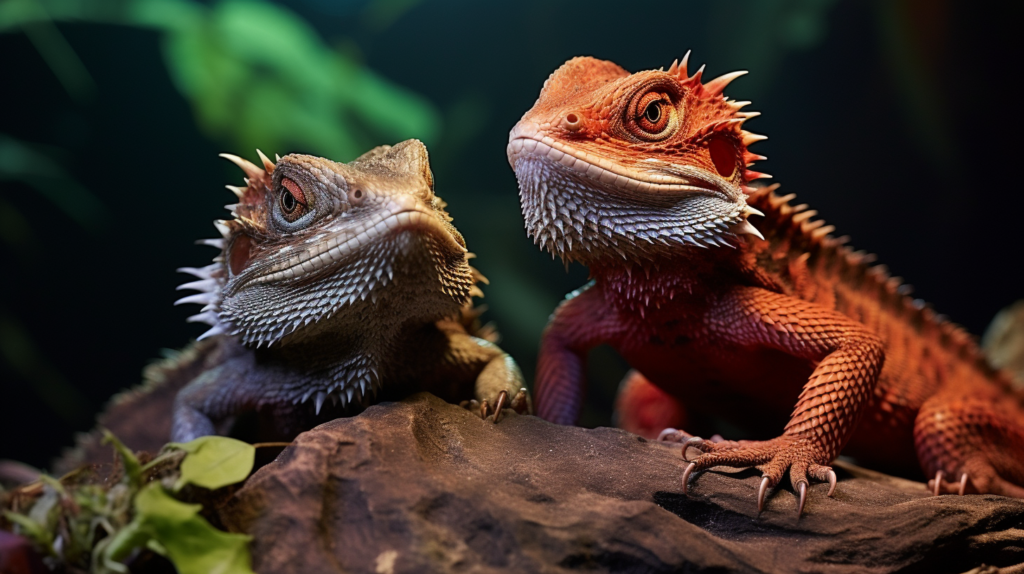As a bearded dragon owner, you've likely observed their unique mannerisms and behaviors, but have you truly unraveled the depth of their quirky charms? From their subtle nods and waves to their mesmerizing color-changing abilities, these reptiles have a fascinating way of communicating and expressing themselves.
But there's more to their behavior than meets the eye. Understanding the intricacies of your bearded dragon's body language can provide valuable insights into their well-being and contentment.
So, what exactly do these mannerisms reveal, and how can you decode the enchanting world of bearded dragon behavior?
Bearded Dragon Body Language
Bearded dragon body language is a fascinating aspect of their communication, encompassing distinct gestures and color changes that convey a range of emotional states and social signals. Their behavior and body language can provide valuable insights into their well-being.
For instance, head bobbing and arm waving are common behaviors seen in bearded dragons. These actions can indicate dominance, submission, mating initiation, or stress. Understanding these gestures is crucial for interpreting their emotional state and ensuring their welfare.
In addition to gestures, the color changes in a bearded dragon's beard play a significant role in their communication. A black beard often signifies that the dragon feels threatened, stressed, or aroused. On the other hand, a beard that matches the rest of the body indicates a calm and content state. This color variation serves as a clear indicator of their emotional well-being.
Moreover, bearded dragons exhibit color changes similar to chameleons, with different regions of their bodies displaying varied hues. These color changes not only aid in social interaction but also play a role in regulating their body temperature. Understanding the significance of these color variations is crucial for caretakers to ensure the dragons' comfort and health.
Communication Through Nods and Waves
Communication through nods and waves in bearded dragons is an intriguing aspect of their social interaction, complementing the body language discussed earlier. Bearded dragons use head bobbing and arm waving to convey various messages to each other and their owners.
Head bobbing is a form of communication that can signify dominance, territoriality, or be a part of the mating ritual. It's essential to pay attention to the context in which head bobbing occurs to interpret its meaning accurately.
On the other hand, arm waving is a sign of submission or non-aggression, and it's more commonly observed in captive dragons. It can also be a part of the mating ritual and serves as a way for the bearded dragon to catch the owner's attention.
Understanding these communication methods is crucial in comprehending a bearded dragon's behavior. Additionally, it's important to recognize that arm waving and head bobbing can be indicative of stress or a need for changes in the dragon's environment.
When interpreting a bearded dragon's behavior, it's essential to consider other body language signals such as puffing up the beard, tail wagging, rapid eye movements, and even glass surfing, which can indicate stress, boredom, or a desire for more space.
Color-changing Capabilities
Utilizing their remarkable color-changing capabilities, bearded dragons demonstrate a complex interplay of physiological and behavioral responses, offering valuable insights into their interactions with the environment and conspecifics.
- Social Signaling: Bearded dragons change the color of their neck region during social interactions. This color change signifies their emotional state and plays a crucial role in communication with other dragons.
- Thermoregulation: The ability to change color in the back area helps bearded dragons regulate their body temperature. Darker colors aid in absorbing more sunlight, while lighter colors reflect it, enabling them to maintain optimal body temperature.
- Selective Color Change: Bearded dragons can isolate specific parts of their body to change color. This selective color change allows them to effectively manage their exposure to sunlight, further assisting in thermoregulation and energy conservation.
- Emotional Expression and Dominance: Color-changing capabilities also play a role in expressing emotional states and possibly in establishing dominance within their social hierarchy. Understanding these color changes provides valuable insights into the well-being and behavior of bearded dragons.
The color-changing abilities of bearded dragons aren't just a fascinating feature but a crucial aspect of their behavioral and physiological adaptations. By observing and understanding these color changes, owners can gain valuable insights into their dragons' well-being, emotional states, and social dynamics.
Incorporating this knowledge into bearded dragon care can facilitate a deeper understanding and enhance the quality of care provided to these remarkable reptiles.
Sleeping and Waking Behaviors
In their natural habitat, bearded dragons display intriguing sleeping and waking behaviors, often adopting unusual positions and movements that reflect their unique adaptations and lifestyle. When it comes to sleeping, bearded dragons exhibit fascinating habits. For instance, they can sleep standing up, a behavior often observed in the wild where they prop themselves vertically against trees. While pet dragons may not have trees to lean on, it's not uncommon for them to sleep in awkward positions against tank walls or ornaments. However, upright sleeping is not a cause for concern. Belly-down sleeping is their typical and presumably more comfortable position. This behavior is important to note, as it can indicate the comfort level and overall well-being of your pet.
To emphasize the variety of sleeping positions adopted by bearded dragons, the following table showcases the different sleeping postures observed in these fascinating creatures:
| Sleeping Behaviors | Description | Significance |
|---|---|---|
| Standing up | Common in the wild, propped against trees. | Reflects natural behavior. |
| Awkward positions | Pet dragons may sleep against tank walls or ornaments. | Normal for captivity. |
| Belly-down sleeping | Typical and comfortable position for bearded dragons. | Indicates comfort and well-being. |
Understanding these sleeping behaviors is essential for providing the best care for your bearded dragon. By observing their sleeping habits, you can ensure that they are comfortable and thriving in their environment.
Unique Reproductive Traits
With their intriguing sleeping behaviors understood, it's fascinating to pivot to the unique reproductive traits of bearded dragons, shedding light on their remarkable adaptations and reproductive strategies. Understanding these reproductive traits is essential for the health and well-being of these captivating creatures.
- Sperm Storage: Female bearded dragons have the remarkable ability to store sperm, allowing them to lay multiple clutches of eggs after mating only once. This adaptation ensures reproductive success in their natural habitat.
- Asexual Reproduction: Females can lay fertilized eggs without the need for mating again, thanks to the stored sperm in their reproductive tracts. This unique trait provides the flexibility for reproduction in diverse environmental conditions.
- Temperature-Induced Sex Reversal: High temperatures during embryonic development can result in male bearded dragons transitioning to females. This temperature-induced sex reversal occurs at temperatures of 96.8 degrees and above, showcasing the influence of environmental factors on their reproductive biology.
- Uric Acid Excretion: Bearded dragons excrete uric acid as a white powder or chalky paste, instead of liquid urine, to help them retain water in their hot, dry Australian habitat. This adaptation is crucial for their survival in arid conditions.
The bearded dragon's reproductive traits aren't only intriguing but also essential for their survival. Understanding these unique traits is crucial for providing them with the best possible care.
As you delve deeper into the complete guide to bearded dragons, these reproductive adaptations will give you a newfound appreciation for these remarkable creatures.
Frequently Asked Questions
What Is the Bearded Dragon One Year Curse?
The bearded dragon one year curse refers to potential health concerns around their first birthday, including growth spurts, temperament changes, and aggression. Understand the signs to provide timely care and prevent issues.
What Is the Odd Behavior of a Bearded Dragon?
When a bearded dragon exhibits odd behavior, such as tail waving, arm waving, head bobbing, or glass surfing, it could be signaling stress, boredom, or a desire for attention or space. Understanding these actions helps you address their needs effectively.
How Do Bearded Dragons Show They Love You?
Bearded dragons show love through affectionate gestures like gentle licking, resting on your shoulder, and closing their eyes when petted. They express emotions by recognizing your voice, tilting their head, and displaying head bobbing as signs of attachment.
What Is an Abnormal Behavior for a Bearded Dragon?
If your bearded dragon exhibits rapid eye movement, especially during sleep, it could indicate stress or discomfort. Glass surfing, head bobbing, and tail twitching are also abnormal behaviors that may signal anxiety or the need for environmental adjustments.
Conclusion
As you observe your bearded dragon's nodding and waving, color-changing, and unique reproductive traits, you can't help but marvel at the quirky charms of these fascinating creatures.
Their body language and behaviors reveal a complex and captivating world, waiting to be explored.
By understanding and interpreting these mannerisms, you can deepen your bond with your bearded dragon and appreciate the wonder of nature's intricacies.
Keep observing and learning, and you'll continue to uncover the delightful quirks of your beloved reptile.


